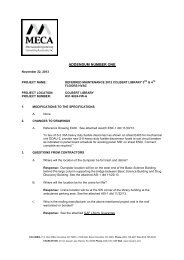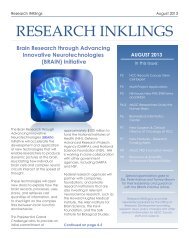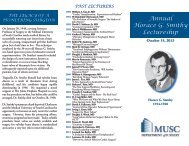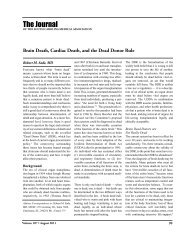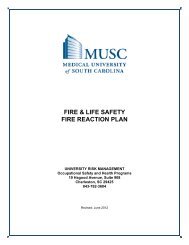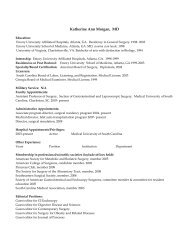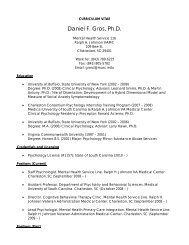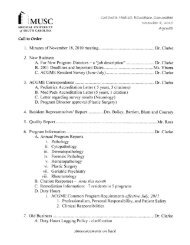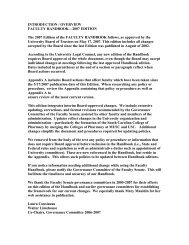Quintero et al. 2006 - Medical University of South Carolina
Quintero et al. 2006 - Medical University of South Carolina
Quintero et al. 2006 - Medical University of South Carolina
You also want an ePaper? Increase the reach of your titles
YUMPU automatically turns print PDFs into web optimized ePapers that Google loves.
Research Report<br />
Behavior<strong>al</strong> and morphologic<strong>al</strong> effects <strong>of</strong> minocycline in the<br />
6-hydroxydopamine rat model <strong>of</strong> Parkinson's disease<br />
Elias Matthew <strong>Quintero</strong> a, ⁎, Lauren Willis a , Rachel Singl<strong>et</strong>on a , Naida Harris b , Peng Huang c ,<br />
Narayan Bhat a , Ann-Charlotte Granholm a<br />
a<br />
Department <strong>of</strong> Neurosciences, Medic<strong>al</strong> <strong>University</strong> <strong>of</strong> <strong>South</strong> <strong>Carolina</strong>, 173 Ashley Avenue, Suite 403, Charleston, SC 29425, USA<br />
b<br />
Benedict College, Columbia, SC 29204, USA<br />
c<br />
Department <strong>of</strong> Biostatistics, Bioinformatics and Epidemiology, Medic<strong>al</strong> <strong>University</strong> <strong>of</strong> <strong>South</strong> <strong>Carolina</strong>, Charleston, SC 29425, USA<br />
ARTICLE INFO ABSTRACT<br />
Article history:<br />
Accepted 20 March <strong>2006</strong><br />
Available online 18 May <strong>2006</strong><br />
Keywords:<br />
Parkinson's disease<br />
6-Hydroxydopamine<br />
Minocycline<br />
Apomorphine<br />
Inflammation<br />
Neuroglia<br />
1. Introduction<br />
Neuroinflammation mediated by activated gli<strong>al</strong> cells has<br />
recently been investigated as a causatory factor for Parkin-<br />
⁎ Corresponding author. Fax: +1 843 792 4423.<br />
E-mail address: quintero@musc.edu (E.M. <strong>Quintero</strong>).<br />
BRAIN RESEARCH 1093 (<strong>2006</strong>) 198– 207<br />
available at www.sciencedirect.com<br />
www.elsevier.com/locate/brainres<br />
0006-8993/$ – see front matter © <strong>2006</strong> Elsevier B.V. All rights reserved.<br />
doi:10.1016/j.brainres.<strong>2006</strong>.03.104<br />
The neuropathology in many neurodegenerative diseases is mediated by inflammatory<br />
cascades that influence neuron<strong>al</strong> dysfunction and death. Minocycline reduces the<br />
neurodegeneration observed in various models <strong>of</strong> Parkinson's. We exploited the unilater<strong>al</strong><br />
6-hydroxydopamine (6-OHDA) lesion model to assess the effect <strong>of</strong> minocycline on related<br />
neurodegeneration. Thirty Fisher 344 rats were divided into three daily treatment groups: (1)<br />
after: 45 mg/kg <strong>of</strong> minocycline beginning 24 h after lesioning; (2) before: 45 mg/kg <strong>of</strong><br />
minocycline beginning 3 days before 6-OHDA lesioning; (3) control: corresponding s<strong>al</strong>in<strong>et</strong>reated<br />
controls. Anim<strong>al</strong>s were assessed for apomorphine-induced rotations for 4 weeks. A<br />
longitudin<strong>al</strong> model for repeated measures showed that both after and before groups had<br />
significantly lower rotations than controls (P < 0.001 for both comparisons). Pair-wise group<br />
comparisons showed that the before anim<strong>al</strong>s rotated less compared to controls (mean<br />
rotations: 164 ± 38 versus 386 ± 49, respectively, P = 0.001). After anim<strong>al</strong>s <strong>al</strong>so rotated<br />
significantly less then controls (mean rotations: 125 ± 41 versus 386 ± 49, respectively,<br />
P < 0.001). Anim<strong>al</strong>s receiving minocycline displayed reduced tyrosine hydroxylase-positive<br />
cell loss in the lesioned nigra versus contr<strong>al</strong>ater<strong>al</strong> nonlesioned nigra, compared to controls<br />
(mean differences: 5065 for after, 3550 for before, and 6483 for controls; P = 0.158 for after<br />
versus controls, P = 0.019 for before versus controls). The remaining lesioned nigr<strong>al</strong> cells <strong>of</strong><br />
both minocycline-treated groups were larger than controls, with the most robust cell size<br />
and fiber density observed in the after group. These data suggest that the therapeutic<br />
potenti<strong>al</strong> <strong>of</strong> minocycline may depend on the time <strong>of</strong> drug administration relative to<br />
neuropathogenic event.<br />
© <strong>2006</strong> Elsevier B.V. All rights reserved.<br />
son's disease (PD), an age-related neurodegenerative disease<br />
(Barcia <strong>et</strong> <strong>al</strong>., 2003; Dawson and Dawson, 2003). Studies have<br />
shown that activated microgli<strong>al</strong> cells surround dopaminergic<br />
neurons in patients with this disease and produce damaging
cytokines that may be directly responsible for the demise <strong>of</strong><br />
the dopamine (DA) neurons (Hirsch <strong>et</strong> <strong>al</strong>., 2003; Hunot and<br />
Hirsch, 2003). Activated glia (astrocytes and microglia) <strong>al</strong>so<br />
contribute towards the rampant oxidative stress that is<br />
associated with the neurodegenerative process via excessive<br />
production <strong>of</strong> neurotoxic free radic<strong>al</strong>s (Abramov <strong>et</strong> <strong>al</strong>., 2004;<br />
Leblhuber <strong>et</strong> <strong>al</strong>., 2003). Although astrocytes norm<strong>al</strong>ly protect<br />
neurons through their production <strong>of</strong> growth and trophic<br />
molecules, “aging” astrocytes, because <strong>of</strong> their expression <strong>of</strong><br />
pro-oxidant enzymes such as MAO-B and a high content <strong>of</strong><br />
free iron, can promote enzymatic and nonenzymatic oxidation<br />
<strong>of</strong> DA, generating toxic levels <strong>of</strong> reactive oxygen species<br />
(Johnstone <strong>et</strong> <strong>al</strong>., 1999; Hirsch <strong>et</strong> <strong>al</strong>., 2003).<br />
Minocycline, a second generation t<strong>et</strong>racycline, has recently<br />
f<strong>al</strong>len under close scrutiny as having possible therapeutic v<strong>al</strong>ue<br />
for treating sever<strong>al</strong> neurodegenerative disorders, including<br />
Huntington's disease (Chen <strong>et</strong> <strong>al</strong>., 2000), amyotrophic later<strong>al</strong><br />
sclerosis (Zhu <strong>et</strong> <strong>al</strong>., 2002), and autoimmune enceph<strong>al</strong>omyelitis<br />
(Popovic <strong>et</strong> <strong>al</strong>., 2001). Studies in models <strong>of</strong> PD, including the 1m<strong>et</strong>hyl-4-phenyl-1,2,3,6-t<strong>et</strong>rahydropyridine<br />
(MPTP) model (Du<br />
<strong>et</strong> <strong>al</strong>., 2001; Wu <strong>et</strong> <strong>al</strong>., 2002) and the 6-hydroxydopamine (6-<br />
OHDA) model (He <strong>et</strong> <strong>al</strong>., 2001), have provided compelling<br />
evidence that minocycline possesses vast potenti<strong>al</strong> for attenuation<br />
<strong>of</strong> the neurodegenerative changes that occur in the brain.<br />
In particular, He <strong>et</strong> <strong>al</strong>. (2001) compared the effects <strong>of</strong><br />
minocycline treatment to s<strong>al</strong>ine controls on nigr<strong>al</strong> dopaminergic<br />
neuron<strong>al</strong> and microgli<strong>al</strong> status in m<strong>al</strong>e mice lesioned in the<br />
right striatum with 6-OHDA. Tyrosine hydroxylase (TH) immunohistochemistry<br />
reve<strong>al</strong>ed a significant sparing <strong>of</strong> dopamine<br />
neurons in anim<strong>al</strong>s receiving minocycline treatment. In<br />
addition, the number <strong>of</strong> activated microglia was significantly<br />
decreased in those anim<strong>al</strong>s that received minocycline compared<br />
to their s<strong>al</strong>ine counterparts. Lin <strong>et</strong> <strong>al</strong>. (2003) reported that<br />
minocycline reduced the susceptibility <strong>of</strong> cultured rat cerebellar<br />
granule neurons to 6-OHDA-induced death and prevented the<br />
production <strong>of</strong> free radic<strong>al</strong>s following 6-OHDA administration.<br />
These two studies clearly demonstrate that minocycline<br />
impacts the toxicity associated with 6-OHDA administration<br />
and establish the possibility <strong>of</strong> manipulating the degenerative<br />
cascade that follows upon introduction <strong>of</strong> this toxin. However,<br />
6-OHDA studies in the rat model combined with minocycline<br />
have been sparse. The <strong>al</strong>lure <strong>of</strong> this phenomenon becomes<br />
apparent when one considers that the biochemic<strong>al</strong> and cellular<br />
events associated with 6-OHDA toxicity may be, at least in part,<br />
similar to the molecular neuroinflammatory cascades that are<br />
engaged in the ons<strong>et</strong> <strong>of</strong> neurodegenerative diseases such as<br />
Parkinson's disease (Hirsch <strong>et</strong> <strong>al</strong>., 1998; Jenner and Olanow,<br />
1998).<br />
Since its first use by Ungerstedt in the late 1960s (Ungerstedt,<br />
1968), the utilization <strong>of</strong> the catecholaminergic neurotoxin<br />
6-hydroxydopamine (6-OHDA) to experiment<strong>al</strong>ly destroy<br />
dopaminergic neurons in the brain has been well documented<br />
and is regarded as the gold standard for studying mesenceph<strong>al</strong>ic<br />
dopamine (DA)-containing neurons (Schwarting and<br />
Huston, 1996a,b; Glinka <strong>et</strong> <strong>al</strong>., 1997; Blum <strong>et</strong> <strong>al</strong>., 2001; Deumens<br />
<strong>et</strong> <strong>al</strong>., 2002). By stereotaxic<strong>al</strong>ly introducing 6-OHDA into<br />
individu<strong>al</strong> components <strong>of</strong> the nigrostriat<strong>al</strong> pathway, we<br />
have gained enormous insight into the neuroanatomic<strong>al</strong>,<br />
neurochemic<strong>al</strong>, and electrophysiologic<strong>al</strong> param<strong>et</strong>ers <strong>of</strong> DAcontaining<br />
neurons and their interaction with other sys-<br />
BRAIN RESEARCH 1093 (<strong>2006</strong>) 198– 207<br />
tems. The most common application <strong>of</strong> this toxin is the<br />
creation <strong>of</strong> a unilater<strong>al</strong> lesion in mesenceph<strong>al</strong>ic DA neurons<br />
or their ascending fibers, which will result in a loss <strong>of</strong> targ<strong>et</strong><br />
striat<strong>al</strong> DA, or into the striatum directly. Consequently, the<br />
efficacy <strong>of</strong> a 6-OHDA unilater<strong>al</strong> lesion can be demonstrated<br />
by DAergic compounds, such as apomorphine or amph<strong>et</strong>amine<br />
(Ungerstedt and Arbuthnott, 1970). The number <strong>of</strong><br />
apomorphine-induced turns per hour has been directly<br />
correlated to the extent <strong>of</strong> DA loss when 6-OHDA is injected<br />
into the medi<strong>al</strong> forebrain bundle (Hudson <strong>et</strong> <strong>al</strong>., 1993). This<br />
strategy has been proven to be an inv<strong>al</strong>uable tool in<br />
studying how diseases, such as PD, may encroach upon<br />
the nigrostriat<strong>al</strong> pathway and how experiment<strong>al</strong> manipulation<br />
<strong>of</strong> this system may provide clues for possible clinic<strong>al</strong><br />
intervention.<br />
For this study, we hypothesize that minocycline will reduce<br />
the number <strong>of</strong> lesioned nigr<strong>al</strong> dopaminergic cells and will<br />
reduce the number <strong>of</strong> apomorphine-induced rotations in rats<br />
when administered prior to or after receiving a unilater<strong>al</strong> 6-<br />
OHDA lesion. In order to test the preventive effects <strong>of</strong> this<br />
drug, daily intraperitone<strong>al</strong> injections <strong>of</strong> s<strong>al</strong>ine or minocycline<br />
were initiated 3 days prior to neurotoxic lesioning and<br />
continued for 4 weeks postlesioning. We <strong>al</strong>so assessed the<br />
rescue effects <strong>of</strong> minocycline by administering the drug (as<br />
well as s<strong>al</strong>ine control counterparts) 24 h following 6-OHDA<br />
lesioning and continuing for 4 weeks after surgery. In order to<br />
obtain behavior<strong>al</strong> evidence <strong>of</strong> the neuroprotective properties<br />
<strong>of</strong> this t<strong>et</strong>racycline, weekly apomorphine-induced rotation<strong>al</strong><br />
behavior was assessed on <strong>al</strong>l subjects, and histologic<strong>al</strong><br />
an<strong>al</strong>ysis <strong>of</strong> surviving dopaminergic neurons was performed<br />
following sacrifice <strong>of</strong> <strong>al</strong>l anim<strong>al</strong>s.<br />
2. Results<br />
2.1. Effects <strong>of</strong> minocycline on apomorphine-induced<br />
rotations<br />
199<br />
Apomorphine-induced rotation<strong>al</strong> an<strong>al</strong>ysis was performed in<br />
order to examine the effect <strong>of</strong> minocycline treatment on the<br />
surviv<strong>al</strong> <strong>of</strong> dopaminergic neurons exposed to 6-OHDA. All<br />
anim<strong>al</strong>s were an<strong>al</strong>yzed for apomorphine-induced rotations for<br />
1 h, once a week, for 4 weeks following lesioning (previous<br />
studies indicate that 6-OHDA requires 4 weeks before the full<br />
rotation<strong>al</strong> potenti<strong>al</strong> <strong>of</strong> each anim<strong>al</strong> is re<strong>al</strong>ized (Ungerstedt and<br />
Arbuthnott, 1970; Sauer and Oertel, 1994; Gerlach and<br />
Riederer, 1996). Fig. 1 is a graphic<strong>al</strong> representation <strong>of</strong> the<br />
rotation<strong>al</strong> assessments for the s<strong>al</strong>ine-treated anim<strong>al</strong>s (control<br />
group), minocycline 3 days before lesioning (before group), and<br />
minocycline 24 h after lesioning (after group) over the 4-week<br />
testing period following 6-OHDA administration. The control<br />
group consistently rotated the most number <strong>of</strong> times at each<br />
weekly time point, compared to those anim<strong>al</strong>s that received<br />
minocycline. At 1 week, the mean rotation rate for the controls<br />
was 202 turns per hour compared to 140 turns in the before<br />
and 34 turns in the after groups (n = 10). At 2 weeks postlesion,<br />
the controls rotated 381 turns per hour, whereas the before<br />
and after anim<strong>al</strong>s rotated 138 and 114 turns per hour,<br />
respectively. Three weeks following toxin administration<br />
resulted in 359 turns in the controls, 246 turns in the before
200 BRAIN RESEARCH 1093 (<strong>2006</strong>) 198– 207<br />
Fig. 1 – Minocycline reduces the number <strong>of</strong><br />
apomorphine-induced rotations in the 6-OHDA-lesioned rat.<br />
All anim<strong>al</strong>s that received minocycline rotated significantly<br />
fewer times over the 4-week testing period compared to their<br />
s<strong>al</strong>ine-treated counterparts (P < 0.001). At week 2, anim<strong>al</strong>s<br />
treated before (Before) and after (After) 6-OHDA lesioning<br />
rotated significantly fewer times than the s<strong>al</strong>ine-treated<br />
(Control) anim<strong>al</strong>s (138, 114 and 381 turns, respectively.<br />
P < 0.05). At week 4, the difference in rotations in the after<br />
treated group approached significance (P = 0.07) compared to<br />
the s<strong>al</strong>ine control group.<br />
and 148 turns in the after. Fin<strong>al</strong>ly, the fourth week <strong>of</strong> rotation<strong>al</strong><br />
an<strong>al</strong>ysis reve<strong>al</strong>ed that the controls rotated 430 turns per hour,<br />
while the before rotated 394 turns and the after rotated 149<br />
turns.<br />
A one-way ANOVA showed that there was a significant<br />
difference among the 3 groups in over<strong>al</strong>l turns across <strong>al</strong>l<br />
time points (P < 0.0001). Post hoc two-sample t tests to<br />
compare the after group versus controls, before group versus<br />
controls, and combined after and before versus controls <strong>al</strong>l<br />
yielded P v<strong>al</strong>ues
minocycline treatment. Fig. 2 demonstrates the contrast<br />
b<strong>et</strong>ween lesioned and nonlesioned nigras <strong>of</strong> <strong>al</strong>l three<br />
groups. The dopaminergic neurons <strong>of</strong> the lesioned nigra<br />
readily succumbed to 6-OHDA when treated with s<strong>al</strong>ine<br />
only (Fig. 2A). These results were identic<strong>al</strong> wh<strong>et</strong>her s<strong>al</strong>ine<br />
treatment was initiated before or after 6-OHDA administration.<br />
When minocycline was administered 3 days prior<br />
to 6-OHDA administration and continuously thereafter,<br />
there was a marked sparing <strong>of</strong> dopaminergic neurons in<br />
the substantia nigra 4 weeks following toxin introduction<br />
(Fig. 2B). There was <strong>al</strong>so a similar demonstration <strong>of</strong> nigr<strong>al</strong><br />
cell surviv<strong>al</strong> when minocycline was administered continuously<br />
starting 24 h after 6-OHDA lesioning (Fig. 2C).<br />
Stereologic<strong>al</strong> cell counts <strong>of</strong> TH-positive lesioned and<br />
contr<strong>al</strong>ater<strong>al</strong> nonlesioned nigr<strong>al</strong> cells in each anim<strong>al</strong> was<br />
performed to d<strong>et</strong>ermine the number <strong>of</strong> surviving DA cells 4<br />
weeks after lesioning. To an<strong>al</strong>yze wh<strong>et</strong>her minocycline was<br />
efficient in reducing the number <strong>of</strong> nigr<strong>al</strong> cells that<br />
succumbed to 6-OHDA exposure, we first computed the<br />
difference in cell numbers by subtracting the nigr<strong>al</strong> cell<br />
count <strong>of</strong> the lesioned side from the nigr<strong>al</strong> cell count <strong>of</strong> the<br />
contr<strong>al</strong>ater<strong>al</strong> nonlesioned side in each anim<strong>al</strong> (Fig. 4A). We<br />
then compared the mean difference measures among the<br />
three groups (after, before and control). A one-way an<strong>al</strong>ysis<br />
<strong>of</strong> variance showed that the mean cell differences were<br />
not the same among the three groups (P = 0.034). The<br />
mean cell difference in the controls was 6483 ± 782. The<br />
mean cell difference in <strong>al</strong>l minocycline-treated anim<strong>al</strong>s<br />
(after and before groups combined) was 4388 ± 446. A twosided<br />
t test generated a P v<strong>al</strong>ue <strong>of</strong> 0.047 (P < 0.05), implying<br />
the effectiveness <strong>of</strong> the minocycline treatment. We next<br />
examined wh<strong>et</strong>her early minocycline treatment (before<br />
group) or late minocycline treatment (after group) gives<br />
the best protection for cells against 6-OHDA exposure. We<br />
BRAIN RESEARCH 1093 (<strong>2006</strong>) 198– 207<br />
compared the mean cell differences <strong>of</strong> each minocycline<br />
group (after or before) separately with the control group<br />
v<strong>al</strong>ues using a two-sided t test. The observed mean cell<br />
differences were 3550 ± 628 and 5065 ± 476 in before and<br />
after anim<strong>al</strong>s, respectively. The early minocycline (before)<br />
treated group demonstrated a significant reduction in cell<br />
count loss (P < 0.05) compared to the controls, while the<br />
difference b<strong>et</strong>ween the late (after) minocycline subjects<br />
and controls was not significant (P > 0.1). These data imply<br />
that fewer nigr<strong>al</strong> cells succumbed to 6-OHDA-induced<br />
toxicity in anim<strong>al</strong>s treated with minocycline, particularly<br />
those that began the t<strong>et</strong>racycline three days prior to<br />
lesioning.<br />
Cell size measurements on randomly selected neurons<br />
for each anim<strong>al</strong> (>50 neurons/anim<strong>al</strong>) reve<strong>al</strong>ed a significant<br />
difference in cell size in the lesioned nigra b<strong>et</strong>ween the<br />
three groups (Fig. 4B). The before group had significantly<br />
sm<strong>al</strong>ler neurons than the after group (746.87 ± 35.121<br />
versus 897.07 ± 27.447 square pixels, respectively). The<br />
sm<strong>al</strong>lest cell size measurements were obtained in the<br />
controls (700.62 ± 185.240 square pixels). Significant cell<br />
size differences were observed b<strong>et</strong>ween the before and<br />
after group (P < 0.001) as well as b<strong>et</strong>ween the after and<br />
controls (P < 0.0001). In addition, remaining nigr<strong>al</strong> cells in<br />
the after group appeared more robust with thick neuritic<br />
processes, suggesting intact neuron<strong>al</strong> viability (Fig. 3C).<br />
Thus, it appeared that the cell size, but not the cell<br />
numbers, reflected the <strong>al</strong>terations seen in apomorphineinduced<br />
behavior (see Fig. 3). Subsequent densitom<strong>et</strong>ric<br />
measurements <strong>of</strong> TH-positive nigr<strong>al</strong> fibers <strong>of</strong> <strong>al</strong>l three<br />
groups reve<strong>al</strong>ed that anim<strong>al</strong>s treated with minocycline<br />
24 h after lesioning displayed more numerous thick<br />
sprouting processes compared to those treated with<br />
minocycline 3 days before or s<strong>al</strong>ine only (Fig. 4C). This<br />
Fig. 3 – Minocycline increases TH-immunoreactive cell size and fiber density in lesioned nigras. S<strong>al</strong>ine-treated anim<strong>al</strong>s display<br />
typic<strong>al</strong> degenerative pr<strong>of</strong>iles including sm<strong>al</strong>l, weakly stained cell bodies (A) and sparse dendritic processes (D). However,<br />
minocycline treatment before lesioning (B) and after lesioning (C) appears to enhance neuron<strong>al</strong> cell size and fiber density,<br />
particularly in the after group. Panels (D), (E), and (F) illustrate later<strong>al</strong> nigr<strong>al</strong> fibers <strong>of</strong> s<strong>al</strong>ine-, minocycline before-, and minocycline<br />
after-treated groups, respectively. Note the robust fiber sprouting and density in the minocycline-treated groups, particularly in<br />
the after lesion group (F). (A, B, C: 60× magnification, sc<strong>al</strong>e bar = 20 μm; D, E, F: 40× magnification, sc<strong>al</strong>e bar = 15 μm).<br />
201
202 BRAIN RESEARCH 1093 (<strong>2006</strong>) 198– 207<br />
Fig. 4 – Minocycline reduces TH-positive cell loss and<br />
increases the size and fiber density <strong>of</strong> remaining nigr<strong>al</strong> cells.<br />
The degree <strong>of</strong> cell loss is more attenuated in the minocycline<br />
before group than the after group, compared to the s<strong>al</strong>ine<br />
controls (A, *P < 0.05). However, close inspection reve<strong>al</strong>s that<br />
anim<strong>al</strong>s receiving minocycline after lesioning contained<br />
larger, more he<strong>al</strong>thy looking cells than either the minocycline<br />
before or s<strong>al</strong>ine controls (B, *P < 0.001, **P < 0.0001). In<br />
addition, the lesioned nigras <strong>of</strong> <strong>al</strong>l minocycline-treated<br />
anim<strong>al</strong>s contained more dense sprouting fibers compared to<br />
controls, especi<strong>al</strong>ly in the after group (C). See text for d<strong>et</strong>ails.<br />
was particularly evident in the later<strong>al</strong> nigra <strong>of</strong> <strong>al</strong>l anim<strong>al</strong>s<br />
an<strong>al</strong>yzed.<br />
3. Discussion<br />
Apomorphine-induced rotation<strong>al</strong> results and TH immunohistochemistry<br />
an<strong>al</strong>yses support our hypothesis that minocycline<br />
reduces the number <strong>of</strong> rotations and spares DA-containing<br />
nigr<strong>al</strong> neurons in 6-OHDA unilater<strong>al</strong>ly lesioned rats. We<br />
utilized apomorphine to ev<strong>al</strong>uate the extent <strong>of</strong> DA depl<strong>et</strong>ion<br />
because it serves as a more reliable predictor <strong>of</strong> lesion efficacy<br />
following 6-OHDA administration and avoids the possibility <strong>of</strong><br />
sensitization associated with D-amph<strong>et</strong>amine (Hudson <strong>et</strong> <strong>al</strong>.,<br />
1993; Carman <strong>et</strong> <strong>al</strong>., 1991; Casas <strong>et</strong> <strong>al</strong>., 1988). Anim<strong>al</strong>s receiving<br />
daily minocycline beginning 3 days prior to lesioning rotated<br />
<strong>al</strong>most h<strong>al</strong>f as many times as their s<strong>al</strong>ine-treated counterparts.<br />
Surprisingly, those anim<strong>al</strong>s that began their regimen <strong>of</strong><br />
minocycline 24 h after lesioning displayed over a 50%<br />
reduction in apomorphine-induced rotations compared to<br />
their corresponding s<strong>al</strong>ine-treated lesioned counterparts,<br />
suggesting that minocycline optim<strong>al</strong>ly spared DA depl<strong>et</strong>ion<br />
when administered after surgic<strong>al</strong> lesioning. Stereologic counts<br />
and cell size measurements demonstrated a greater sparing <strong>of</strong><br />
neurons on the lesioned side <strong>of</strong> anim<strong>al</strong>s that received<br />
minocycline before the lesion, <strong>al</strong>though these cells displayed<br />
a more atrophied pr<strong>of</strong>ile. In contrast, fewer nigr<strong>al</strong> cells<br />
remained in anim<strong>al</strong>s receiving minocycline after the lesion.<br />
Interestingly, the remaining nigr<strong>al</strong> cells in anim<strong>al</strong>s treated<br />
with minocycline after lesioning appeared much larger than<br />
the lesioned nigr<strong>al</strong> cells in the other two groups and contained<br />
numerous thick, darkly stained neuron<strong>al</strong> fibers, particularly in<br />
the later<strong>al</strong> nigr<strong>al</strong> area. It is possible that minocycline administered<br />
24 h after lesioning promoted he<strong>al</strong>thier surviving THpositive<br />
nigr<strong>al</strong> cells, compared to anim<strong>al</strong>s that began their<br />
treatment three days prior to lesioning.<br />
When 6-OHDA injections are administered into the MFB,<br />
there is minim<strong>al</strong> variability, and there is >90% success in<br />
obtaining anim<strong>al</strong>s with more than 90% reduction in striat<strong>al</strong> DA<br />
levels using this m<strong>et</strong>hod (Hudson <strong>et</strong> <strong>al</strong>., 1993; Bowenkamp <strong>et</strong><br />
<strong>al</strong>., 1995; Granholm <strong>et</strong> <strong>al</strong>., 1997). Thus, the technique is reliable<br />
and reproducible. Extensive use <strong>of</strong> 6-OHDA in our laboratory<br />
and from other investigators has clearly demonstrated that<br />
sham-operated controls do not display neurodegenerative<br />
characteristics typic<strong>al</strong>ly present in toxin-treated subjects. In<br />
recent studies in our laboratory utilizing minocycline, Hunter<br />
<strong>et</strong> <strong>al</strong>. reported that the number <strong>of</strong> remaining cells in shamlesioned<br />
anim<strong>al</strong>s treated with minocycline did not differ from<br />
that in sham-lesioned anim<strong>al</strong>s receiving s<strong>al</strong>ine (Hunter <strong>et</strong> <strong>al</strong>.,<br />
2004b), suggesting that minocycline did not <strong>al</strong>ter the bas<strong>al</strong><br />
histologic<strong>al</strong> pr<strong>of</strong>ile observed in host brains. Based on the fact<br />
that we found no effects <strong>of</strong> minocycline in control anim<strong>al</strong>s<br />
after up to 3 months <strong>of</strong> treatment (Hunter <strong>et</strong> <strong>al</strong>., 2004b), we<br />
opted to not include sham-lesioned controls in the present<br />
study. In addition, inspection <strong>of</strong> the contr<strong>al</strong>ater<strong>al</strong> histologic<strong>al</strong><br />
data among <strong>al</strong>l groups in this study corroborates the ration<strong>al</strong>e<br />
to exclude sham-lesioned anim<strong>al</strong>s in that there are no<br />
observable effects <strong>of</strong> minocycline on the unlesioned side <strong>of</strong><br />
the brain.<br />
In order to interpr<strong>et</strong> the data presented here, one must<br />
consider the time course <strong>of</strong> degeneration in nigr<strong>al</strong> dopaminergic<br />
neurons following a 6-OHDA lesion. Earlier studies<br />
using 6-OHDA have d<strong>et</strong>ermined that the behavior<strong>al</strong> phenotype<br />
begins 1 week following toxin administration, when there<br />
is a greater than 60–80% depl<strong>et</strong>ion <strong>of</strong> striat<strong>al</strong> DA; this<br />
behavior<strong>al</strong> phenotype is fully evident at about 4 weeks<br />
(Ungerstedt and Arbuthnott, 1970; Sauer and Oertel, 1994;<br />
Gerlach and Riederer, 1996). In a previous study to d<strong>et</strong>ermine<br />
the tempor<strong>al</strong> pattern <strong>of</strong> acute phenotypic and degenerative<br />
<strong>al</strong>terations following 6-OHDA lesions in the MFB <strong>of</strong> rats, Zuch<br />
<strong>et</strong> <strong>al</strong>. (Zuch <strong>et</strong> <strong>al</strong>., 2000) demonstrated that events leading to<br />
dopaminergic neuron<strong>al</strong> loss begin <strong>al</strong>most immediately
following introduction <strong>of</strong> the toxin. FluoroJade staining, a<br />
marker for cell death, was evident in the ipsilater<strong>al</strong> substantia<br />
nigra pars compacta as early as 6 h postlesion, peaking at 48 h<br />
following toxin administration. Tyrosine hydroxylase immunohistochemistry<br />
<strong>of</strong> corresponding sections reve<strong>al</strong>ed that<br />
degenerative <strong>al</strong>terations to DA neurons were evident at 6 h<br />
postlesion and progressed to a dramatic loss <strong>of</strong> TH immunoreactivity<br />
in the ventromedi<strong>al</strong> substantia nigra pars compacta<br />
by 96 h postlesion. These data clearly demonstrate that the<br />
degenerative changes following 6-OHDA administration begin<br />
within the first 24 h after exposure.<br />
Early characterizations <strong>of</strong> the mechanisms <strong>of</strong> 6-OHDAinduced<br />
degeneration have established that the toxin is<br />
oxidized to reactive oxygen species, affects apoptosis (Choi<br />
<strong>et</strong> <strong>al</strong>., 1999; Lotharius <strong>et</strong> <strong>al</strong>., 1999) and promotes the<br />
production <strong>of</strong> proinflammatory cytokines (Mladenovic <strong>et</strong> <strong>al</strong>.,<br />
2004; Mogi <strong>et</strong> <strong>al</strong>., 1999). There is well documented evidence<br />
that minocycline imparts its anti-inflammatory properties by<br />
inhibiting the activation <strong>of</strong> microglia and attenuating the p38<br />
MAPK cascade with resultant reduction <strong>of</strong> inflammatory<br />
cytokine synthesis (Yrjänheikki <strong>et</strong> <strong>al</strong>., 1998; Tikka <strong>et</strong> <strong>al</strong>.,<br />
2001; Wu <strong>et</strong> <strong>al</strong>., 2002). These anti-inflammatory properties<br />
were origin<strong>al</strong>ly identified in studies <strong>of</strong> brain ischemia<br />
(Yrjänheikki <strong>et</strong> <strong>al</strong>., 1998; 1999). In addition, previous reports<br />
reve<strong>al</strong> that minocycline is capable <strong>of</strong> blocking components <strong>of</strong><br />
pro-apoptotic pathways, including a reduction in the formation<br />
<strong>of</strong> caspase-3 and caspase-1 (Zhu <strong>et</strong> <strong>al</strong>., 2002; Wang <strong>et</strong> <strong>al</strong>.,<br />
2003; Arvin <strong>et</strong> <strong>al</strong>., 2002; Chen <strong>et</strong> <strong>al</strong>., 2000). It is likely that these<br />
events are being influenced by the minocycline administration<br />
in our study. Therefore, this drug may be an effective tool<br />
in d<strong>et</strong>erring both caspase-dependent and -independent<br />
components <strong>of</strong> neurodegenerative cascades.<br />
It is possible that the differences in toxin susceptibility<br />
observed in this study could be due to an interaction b<strong>et</strong>ween<br />
minocycline and 6-OHDA such that the full effect <strong>of</strong> the toxin<br />
may not have been re<strong>al</strong>ized. For instance, it is evident that<br />
the reduction in number <strong>of</strong> lesioned nigr<strong>al</strong> cells by 6-OHDA<br />
was more attenuated by minocycline in the before than the<br />
after group. However, an interaction b<strong>et</strong>ween minocycline<br />
and 6-OHDA is unlikely. T<strong>et</strong>racyclines such as minocycline<br />
impart their bacteriostatic effects by binding to a single high<br />
affinity site on the bacteri<strong>al</strong> 30S ribosome within the cell,<br />
effectively blocking the entry <strong>of</strong> aminoacyl transfer RNA into<br />
the A site <strong>of</strong> the ribosome, preventing elongation <strong>of</strong> amino<br />
acid residues into polypeptide chains, and inhibiting protein<br />
synthesis (Zhanel <strong>et</strong> <strong>al</strong>., 2004). As for its anti-inflammatory<br />
properties, the literature fully supports two mechanisms <strong>of</strong><br />
cell death prevention by t<strong>et</strong>racyclines: potent inhibition <strong>of</strong><br />
innate and adaptive immunity components and obstruction<br />
<strong>of</strong> apoptotic cascades (Domercg and Matute, 2004). Fin<strong>al</strong>ly, a<br />
comprehensive consultation with the Medic<strong>al</strong> <strong>University</strong> <strong>of</strong><br />
<strong>South</strong> <strong>Carolina</strong> Drug Information Center has reve<strong>al</strong>ed no<br />
reported documentation or theor<strong>et</strong>ic<strong>al</strong> interaction b<strong>et</strong>ween<br />
minocycline (or other similar t<strong>et</strong>racyclines) and DA or DA<br />
an<strong>al</strong>ogs, such as L-DOPA and hydroxydopamine, based on 12<br />
major drug references, including many primary literature<br />
sources (person<strong>al</strong> communication).<br />
Current publications have proposed that the proinflammatory<br />
response <strong>of</strong> microgli<strong>al</strong> cells in the brain may consist <strong>of</strong><br />
both del<strong>et</strong>erious and benefici<strong>al</strong> responses (V<strong>al</strong>lat-Decouve-<br />
BRAIN RESEARCH 1093 (<strong>2006</strong>) 198– 207<br />
203<br />
laere <strong>et</strong> <strong>al</strong>., 2003; Teismann <strong>et</strong> <strong>al</strong>., 2003). Most recently, a study<br />
examining the effects <strong>of</strong> blueberry- and spirulina-enriched<br />
di<strong>et</strong>s on striat<strong>al</strong> dopamine recovery following 6-OHDA lesioning<br />
reve<strong>al</strong>ed that an early phase <strong>of</strong> activated microgli<strong>al</strong><br />
response is associated with successful dopaminergic protection<br />
(Strömberg <strong>et</strong> <strong>al</strong>., 2005). When the activated microgliaassociated<br />
OX-6 expression was suppressed using antisense to<br />
TNFα, more severe dopamine depl<strong>et</strong>ion was observed. Alternatively,<br />
others have reported that delayed inhibition <strong>of</strong><br />
cytokine release and microgli<strong>al</strong> activation following 6-OHDA<br />
lesioning will result in less severe dopamine destruction<br />
(Gemma <strong>et</strong> <strong>al</strong>., 2003). Collectively, these data support the<br />
possibility <strong>of</strong> an initi<strong>al</strong> benefici<strong>al</strong> microgli<strong>al</strong> response to<br />
neuroinflammation and, if left unabated, subsequent d<strong>et</strong>riment<strong>al</strong><br />
effect. If this phenomenon holds true, it may explain<br />
why we observed a greater loss <strong>of</strong> TH-positive nigr<strong>al</strong> cells but<br />
b<strong>et</strong>ter rotation<strong>al</strong> phenotype in the minocycline after group,<br />
compared to the minocycline before group. Because the early<br />
benefici<strong>al</strong> wave was reduced in the before group but was<br />
present in the after group, the remaining nigr<strong>al</strong> cells may be<br />
more he<strong>al</strong>thy with enhanced fiber arborization in the latter,<br />
suggesting continued nigr<strong>al</strong> destruction but more viable<br />
dopaminergic function because this first wave <strong>of</strong> gli<strong>al</strong><br />
response is preserved. Indeed, upon examination <strong>of</strong> <strong>al</strong>l<br />
histologic<strong>al</strong> preparations for this study, we observed a marked<br />
increase in size and fiber density <strong>of</strong> the remaining TH-positive<br />
cells in anim<strong>al</strong>s treated with minocycline 24 h after 6-OHDA<br />
lesioning, compared to the other two groups. Neuron<strong>al</strong> cell<br />
size measurements reve<strong>al</strong>ed that, <strong>al</strong>though stereology identified<br />
more TH-positive cells in the lesioned nigra <strong>of</strong> anim<strong>al</strong>s<br />
exposed to minocycline before neurotoxin exposure, these<br />
cells displayed more classic apoptotic pr<strong>of</strong>iles (e.g., sm<strong>al</strong>ler,<br />
ruptured cells with dense, clumped vesicular bodies in the<br />
neuropil, <strong>et</strong>c.) than cells in the after group. Addition<strong>al</strong>ly, many<br />
<strong>of</strong> the lesioned nigr<strong>al</strong> neurons in the before group displayed<br />
fewer or absent neuritic processes when compared to the after<br />
group. We propose that the b<strong>et</strong>ter outcome in apomorphine<br />
rotation<strong>al</strong> an<strong>al</strong>yses in the after group may be due to fewer but<br />
he<strong>al</strong>thier TH-containing neurons remaining because the<br />
initi<strong>al</strong> benefici<strong>al</strong> wave <strong>of</strong> microgli<strong>al</strong> response is preserved. A<br />
more in-depth examination <strong>of</strong> the timing <strong>of</strong> minocycline<br />
administration on neuron<strong>al</strong> viability relative to toxin exposure<br />
is currently underway in our laboratory, using markers for cell<br />
death and degeneration.<br />
Previous work demonstrates that inflammation is a key<br />
component <strong>of</strong> the degenerative cascade associated with<br />
Parkinson's disease (McGeer <strong>et</strong> <strong>al</strong>., 2001; Cicch<strong>et</strong>ti <strong>et</strong> <strong>al</strong>.,<br />
2002). Microgli<strong>al</strong> activation, in particular, has been previously<br />
implicated as a key mediator <strong>of</strong> the inflammatory response in<br />
the brain and has been observed in the brains <strong>of</strong> PD patients<br />
(McGeer <strong>et</strong> <strong>al</strong>., 1988). Similar observations have been reported<br />
in PD anim<strong>al</strong> models, such as the 6-OHDA-induced Parkinsonian<br />
rat (Akiyama and McGeer, 1989; He <strong>et</strong> <strong>al</strong>., 1999). Indeed,<br />
we <strong>al</strong>so observe this phenomenon in our 6-OHDA-lesioned<br />
anim<strong>al</strong>s following CD11b immunohistochemistry for microgli<strong>al</strong><br />
status (data not shown). Although the activation <strong>of</strong><br />
resting microglia is a norm<strong>al</strong> event necessary for maintaining<br />
neuron<strong>al</strong> homeostasis, unabated gliosis associated with a<br />
pathologic<strong>al</strong> state such as PD may exacerbate the neurodegenerative<br />
processes <strong>al</strong>ready established (Hirsch <strong>et</strong> <strong>al</strong>., 1998,
204 BRAIN RESEARCH 1093 (<strong>2006</strong>) 198– 207<br />
2003; Stoll <strong>et</strong> <strong>al</strong>., 2002). Because activated microglia are<br />
associated with phagocytosis and the liberation <strong>of</strong> cytotoxic<br />
molecules (e.g., reactive oxygen species) and proinflammatory<br />
cytokines (e.g., tumor necrosis factor α, interleukin-1β,<br />
interferon-γ), it is probable that chronic microgli<strong>al</strong> activation<br />
will significantly contribute to the destruction <strong>of</strong> resident<br />
cells. Because minocycline easily passes through the blood–<br />
brain barrier, it may be indicated as a d<strong>et</strong>errent to the<br />
inflammatory environment observed in diseases like Parkinson's,<br />
Alzheimer's and others.<br />
These data are concordant with previous literature that<br />
supports the therapeutic potenti<strong>al</strong> <strong>of</strong> minocycline against<br />
neurodegenerative events. Our findings suggest that the time<br />
<strong>of</strong> minocycline delivery relative to neuropathogenic event<br />
may d<strong>et</strong>ermine the effectiveness <strong>of</strong> this drug for therapy.<br />
However, recent studies suggest that minocycline treatment<br />
may lead to adverse effects clinic<strong>al</strong>ly, especi<strong>al</strong>ly after longterm<br />
use (Porter and Harrison, 2003; Wolthuis <strong>et</strong> <strong>al</strong>., 2003; Abe<br />
<strong>et</strong> <strong>al</strong>., 2003; Bradfield <strong>et</strong> <strong>al</strong>., 2003). Although these reports<br />
have been generated in the clinic<strong>al</strong> s<strong>et</strong>ting, it is readily<br />
apparent that further, comprehensive ev<strong>al</strong>uations <strong>of</strong> longterm<br />
minocycline use must be pursued before this t<strong>et</strong>racycline<br />
can gain univers<strong>al</strong> acceptance to treat neurodegenerative<br />
diseases.<br />
4. Experiment<strong>al</strong> procedures<br />
4.1. Minocycline protocol<br />
Thirty m<strong>al</strong>e Fisher 344 rats (200 grams) were lesioned with 6-<br />
OHDA (see d<strong>et</strong>ails below) and randomly divided into three<br />
groups (n = 10). One group received daily IP injections <strong>of</strong><br />
45 mg/kg <strong>of</strong> minocycline (ICN Biomedic<strong>al</strong>s, Inc.) beginning 3<br />
days prior to lesioning. Another group received daily IP<br />
injections <strong>of</strong> 45 mg/kg <strong>of</strong> minocycline beginning 24 h after 6-<br />
OHDA lesioning. The remaining control group received daily<br />
IP s<strong>al</strong>ine injections either 3 days before or 24 h after lesioning.<br />
All anim<strong>al</strong>s continued to receive daily injections <strong>of</strong> 45 mg/kg<br />
<strong>of</strong> minocycline or s<strong>al</strong>ine for 1 week following surgic<strong>al</strong><br />
procedures. After this period, <strong>al</strong>l injections were reduced to<br />
every other day for the remainder <strong>of</strong> the 4-week rotation<strong>al</strong><br />
an<strong>al</strong>ysis phase. All experiments were carried out in accordance<br />
with the Nation<strong>al</strong> Institutes <strong>of</strong> He<strong>al</strong>th Guide for the<br />
Care and Use <strong>of</strong> Laboratory Anim<strong>al</strong>s (NIH Publications No. 80-<br />
23; revised 1996).<br />
4.2. 6-Hydroxydopamine lesioning<br />
All anim<strong>al</strong>s were anesth<strong>et</strong>ized with chlor<strong>al</strong> hydrate (400 mg/kg<br />
in 0.9% NaCl, IP) and stereotaxic<strong>al</strong>ly lesioned in the right<br />
medi<strong>al</strong> forebrain bundle with 9 μg/4 μl <strong>of</strong> 6-OHDA in s<strong>al</strong>ine<br />
containing 0.02% ascorbate (coordinates −4.4 mm AP, +1.3 mm<br />
ML, and −7.8 mm DV from the dur<strong>al</strong> surface; see Granholm <strong>et</strong><br />
<strong>al</strong>., 1997). The 6-OHDA neurotoxin was administered over<br />
4 min followed by a 2-min period delay prior to needle<br />
withdraw<strong>al</strong> to <strong>al</strong>low for toxin absorption into the brain<br />
tissue. Anim<strong>al</strong>s were provided with ac<strong>et</strong>aminophen in their<br />
drinking water for 24 h to <strong>al</strong>leviate potenti<strong>al</strong> postsurgic<strong>al</strong><br />
discomfort.<br />
4.3. Rotation<strong>al</strong> ev<strong>al</strong>uation<br />
All anim<strong>al</strong>s included in this study were ev<strong>al</strong>uated for<br />
apomorphine induced rotation<strong>al</strong> behavior beginning 1 week<br />
following 6-OHDA administration and tested once a week<br />
thereafter for a tot<strong>al</strong> <strong>of</strong> 4 weeks. Briefly, anim<strong>al</strong>s were placed in<br />
rotom<strong>et</strong>er bowls (Hudson <strong>et</strong> <strong>al</strong>., 1993) and secured to the<br />
counting sensor by a thoracic harness. Subjects were <strong>al</strong>lowed<br />
to acclimate to the environment for 10 min, then administered<br />
a subcutaneous injection <strong>of</strong> apomorphine (0.05 mg/kg).<br />
Subsequent rotation<strong>al</strong> behavior was then recorded for 1 h.<br />
Following rotation<strong>al</strong> testing, anim<strong>al</strong>s were released from their<br />
harnesses, removed from the rotom<strong>et</strong>er bowls, and r<strong>et</strong>urned<br />
to their cages.<br />
4.4. Immunohistochemistry<br />
After 4 weeks, anim<strong>al</strong>s were deeply anesth<strong>et</strong>ized with<br />
H<strong>al</strong>othane (H<strong>al</strong>ocarbon Laboratories). Rats were then perfused<br />
through the aorta with 0.9% s<strong>al</strong>ine followed by 4% paraform<strong>al</strong>dehyde<br />
and transferred to 30% sucrose in phosphatebuffered<br />
s<strong>al</strong>ine the next day. Sections (45 μm) were obtained<br />
from the nigr<strong>al</strong> region <strong>of</strong> each anim<strong>al</strong> using a sliding<br />
microtome (Microm). Sections were processed for free-floating<br />
immunohistochemistry using antibodies against tyrosine<br />
hydroxylase (1:1000, Pel-Freeze Biologic<strong>al</strong>s). Briefly, the sections<br />
were washed and incubated for 48 h with TH antibodies.<br />
The sections were washed again in Tris-buffered s<strong>al</strong>ine (TBS)<br />
and incubated with the secondary antibody reacted with the<br />
ABC solution (Vectastain, Vector Laboratories) and diaminobenzidine<br />
(Sigma) (DAB, 0.0300 g/100 ml imidazole-ac<strong>et</strong>ate<br />
buffer solution, Fisher Scientific). Sections were mounted on<br />
glass slides and cover slipped. Control sections were processed<br />
without primary or secondary antibodies. Sections<br />
from <strong>al</strong>l groups were processed simultaneously in the same<br />
bath, using mesh-bottom incubation wells, to avoid intersection<br />
staining variability (for further d<strong>et</strong>ails, see Granholm<br />
<strong>et</strong> <strong>al</strong>., 2000).<br />
4.5. Stereologic an<strong>al</strong>ysis<br />
Estimated numbers <strong>of</strong> TH-positive cells in the substantia nigra<br />
<strong>of</strong> <strong>al</strong>l anim<strong>al</strong>s were obtained using the optic<strong>al</strong> fractionator<br />
stereologic<strong>al</strong> m<strong>et</strong>hod (StereoInvestigator, MicroBrightfield,<br />
Inc.) according to previously published protocols (Hunter <strong>et</strong><br />
<strong>al</strong>., 2004a). Briefly, the optic<strong>al</strong> fractionator system consisted <strong>of</strong><br />
a computer-assisted image an<strong>al</strong>ysis system including a Nikon<br />
Eclipse E-600 microscope hard coupled to a Prior H128<br />
computer-controlled x–y–z motorized stage, an Olympus 750<br />
video camera system, a Micron Pentium III computer and the<br />
Stereoinvestigator stereologic<strong>al</strong> s<strong>of</strong>tware (Microbrightfield<br />
Inc.). The region <strong>of</strong> interest was outlined under low magnification<br />
and the number <strong>of</strong> neurons in the outlined region<br />
measured with a systematic random design <strong>of</strong> disector<br />
counting frames. A 60× objective lens with a 1.4 numeric<strong>al</strong><br />
aperture was used to count and measure individu<strong>al</strong> cells<br />
within the counting frames. The counting brick was approximately<br />
20 μm thick, and upper and lower gard zones were<br />
excluded from counting. Means and standard error <strong>of</strong> the<br />
mean (SEM) <strong>of</strong> estimated cell counts were c<strong>al</strong>culated from the
aw data using the stereology s<strong>of</strong>tware system. The tot<strong>al</strong> cell<br />
number for each lesioned nigra was compared to the cell<br />
number <strong>of</strong> the contr<strong>al</strong>ater<strong>al</strong> nonlesioned nigra. These comparisons<br />
were expressed as a percent decrease <strong>of</strong> cell number<br />
in the lesioned nigra compared to the respective nonlesioned<br />
nigra in the same anim<strong>al</strong>.<br />
4.6. Cell size measurements<br />
In order to d<strong>et</strong>ermine if the surviving neurons were he<strong>al</strong>thy<br />
in <strong>al</strong>l groups or had undergone atrophic <strong>al</strong>terations, we<br />
characterized the size <strong>of</strong> lesioned nigr<strong>al</strong> neurons using Scion<br />
Imaging s<strong>of</strong>tware. Fifty neurons from the lesioned side <strong>of</strong><br />
each anim<strong>al</strong> randomly picked from 5 sections for each<br />
anim<strong>al</strong> were measured. Only cells displaying a clearly<br />
defined nucleus and/or at least two neuritic processes were<br />
considered for measurement. The NIH Image s<strong>of</strong>tware<br />
system is written using Think Pasc<strong>al</strong> from Symantec<br />
Corporation. The perim<strong>et</strong>er <strong>of</strong> each neuron was measured<br />
using a sc<strong>al</strong>e c<strong>al</strong>ibration feature. In addition, fiber density<br />
measurements were made <strong>of</strong> the remaining lesioned nigr<strong>al</strong><br />
neurons in <strong>al</strong>l groups using the Scion Imaging s<strong>of</strong>tware<br />
package.<br />
4.7. Statistic<strong>al</strong> an<strong>al</strong>ysis<br />
The apomorphine-induced rotation data were an<strong>al</strong>yzed using<br />
a one-way ANOVA for <strong>al</strong>l 3 groups followed by sever<strong>al</strong> post hoc<br />
two-sample t tests <strong>of</strong> the mean rotations for different group<br />
pairs. We further an<strong>al</strong>yzed time (week) effect and treatment<br />
effects jointly by using a two-way ANOVA followed by a<br />
sever<strong>al</strong> post hoc paired t tests to find which group demonstrated<br />
significant increase in rotation from week 1 to week 4.<br />
In addition, regression an<strong>al</strong>ysis was used to test for linear<br />
trends in rotations over time for each group. For the cell count<br />
results, the mean <strong>of</strong> the difference b<strong>et</strong>ween lesioned and<br />
nonlesioned nigras <strong>of</strong> each anim<strong>al</strong> for each group was<br />
an<strong>al</strong>yzed using a two-sided t test. Descriptive statistics,<br />
including the mean, median and mode, for each group's cell<br />
size and fiber density measurements were obtained. The<br />
an<strong>al</strong>ysis was done using SAS statistic<strong>al</strong> s<strong>of</strong>tware (SAS<br />
Institute, Inc.) and Statview for Windows.<br />
Acknowledgments<br />
This work was made possible by a grant from the Murray<br />
Center for Parkinson's Disease Research and Related Disorders.<br />
REFERENCES<br />
Abe, M., Furukawa, S., Takayama, S., Michitaka, K., Minami, H.,<br />
Yamamoto, K., Horiike, N., Onji, M., 2003. Drug-induced<br />
hepatitis with autoimmune features during minocycline<br />
therapy. Intern<strong>al</strong> Medicine 42, 48–52.<br />
Abramov, A.Y., Canevari, L., Duchen, M.R., 2004. B<strong>et</strong>a-amyloid<br />
peptides induce mitochondri<strong>al</strong> dysfunction and oxidative<br />
stress in astrocytes and death <strong>of</strong> neurons through activation <strong>of</strong><br />
NADPH oxidase. J. Neurosci. 24, 565–575.<br />
BRAIN RESEARCH 1093 (<strong>2006</strong>) 198– 207<br />
205<br />
Akiyama, H., McGeer, P., 1989. Microgli<strong>al</strong> response to 6hydroxydopamine-induced<br />
substantia nigra lesions. Brain Res.<br />
489, 247–253.<br />
Arvin, K.L., Han, B.H., Du, Y., Lin, S.Z., Paul, S.M., Holtzman, D.M.,<br />
2002. Minocycline markedly protects the neonat<strong>al</strong> brain<br />
against hypoxic–ischemic injury. Ann<strong>al</strong>s. Neurol. 52, 54–61.<br />
Barcia, C., Fernandez-Barreiro, A., Poza, M., Herrero, M.T., 2003.<br />
Parkinson's disease and inflammatory changes. Neurotoxicity<br />
Res. 5, 411–418.<br />
Blum, D., Torch, S., Lambeng, N., Nissou, M., Benabid, A.L., Sadoul,<br />
R., Verna, J.M., 2001. Molecular pathways involved in the<br />
neurotoxicity <strong>of</strong> 6-OHDA, dopamine and MPTP: contribution to<br />
the apoptotic theory in Parkinson's disease. Prog. Neurobiol.<br />
65, 135–172.<br />
Bowenkamp, K.E., H<strong>of</strong>fman, A.F., Gerhardt, G.A., Henry, M.A.,<br />
Biddle, P.T., H<strong>of</strong>fer, B.J., Granholm, A.-C., 1995. Gli<strong>al</strong> cell<br />
line-derived neurotrophic factor supports surviv<strong>al</strong> <strong>of</strong> injured<br />
midbrain dopaminergic neurons. J. Comp. Neurol. 355,<br />
479–489.<br />
Bradfield, Y.S., Robertson, D.M., S<strong>al</strong>omao, D.R., Link, T.P., Rostvold,<br />
J.A., 2003. Minocycline-induced ocular pigmentation. Archives<br />
<strong>of</strong> Ophthamology 121, 144–145.<br />
Carman, L.S., Gage, F.H., Shults, C.W., 1991. Parti<strong>al</strong> lesion <strong>of</strong> the<br />
substantia nigra: relation b<strong>et</strong>ween extent <strong>of</strong> lesion and<br />
rotation<strong>al</strong> behavior. Brain Res. 553, 275–283.<br />
Casas, M., Ferre, S., Cobos, A., Cadaf<strong>al</strong>ch, J., Grau, J.M., Jane, F.,<br />
1988. Comparison b<strong>et</strong>ween apomorphine and<br />
amph<strong>et</strong>amine-induced rotation<strong>al</strong> behaviour in rats with a<br />
unilater<strong>al</strong> nigrostriat<strong>al</strong> pathway lesion. Neuropharmacology<br />
27, 657–659.<br />
Chen, M., Ona, V.O., Li, M., Ferrante, R.J., Fink, K.B., Zhu, S., Bian, J.,<br />
Guo, L., Farrell, L.A., Hersch, S.M., Hobbs, W., Vonsattel, J.P.,<br />
Cha, J.H., Friedlander, R.M., 2000. Minocycline inhibits<br />
caspase-1 and caspase-3 expression and delays mort<strong>al</strong>ity in a<br />
transgenic mouse model <strong>of</strong> Huntington's disease. Nat. Med. 6,<br />
797–801.<br />
Choi, W.S., Yoon, S.Y., Oh, T.H., Choi, E.J., O'M<strong>al</strong>ley, K.L., Oh, Y.J.,<br />
1999. Two distinct mechanisms are involved in 6hydroxydopamine-<br />
and MPP-induced dopaminergic neuron<strong>al</strong><br />
cell death: role <strong>of</strong> caspases, ROS, and JNK. J. Neurosci. Res. 57,<br />
86–94.<br />
Cicch<strong>et</strong>ti, F., Brownell, A.L., Williams, K., Chen, Y.I., Livni, E.,<br />
Isacson, O., 2002. Neuroinflammation <strong>of</strong> the nigrostriat<strong>al</strong><br />
pathway during progressive 6-OHDA dopamine degeneration<br />
in rats monitored by immunohistochemistry and PET imaging.<br />
Eur. J. Neurosci. 15, 991–998.<br />
Dawson, T.M., Dawson, V.L., 2003. Molecular pathways <strong>of</strong><br />
neurodegeneration in Parkinson's disease. Science 302,<br />
819–822.<br />
Deumens, R., Blokland, A., Prickaerts, J., 2002. Modeling<br />
Parkinson's disease in rats: an ev<strong>al</strong>uation <strong>of</strong> 6-OHDA lesions <strong>of</strong><br />
the nigrostriat<strong>al</strong> pathway. Exp. Neurol. 175, 303–317.<br />
Domercg, M., Matute, C., 2004. Neuroprotection by t<strong>et</strong>racyclines.<br />
TIPS 25, 609–612.<br />
Du, Y., Ma, Z., Lin, S., Dodel, R.C., Gao, F., B<strong>al</strong>es, K.R., Triarhou, L.C.,<br />
Chern<strong>et</strong>, E., Perry, K.W., Nelson, D.L.G., Luecke, S., Phebus, L.A.,<br />
Bymaster, F.P., Paul, S., 2001. Minocycline prevents<br />
nigrostriat<strong>al</strong> dopaminergic neurodegeneration in the MPTP<br />
model <strong>of</strong> Parkinson's disease. PNAS 98, 14669–14674.<br />
Gemma, C., Catlow, B., Hudson, C., Bickford, P.C., 2003. Knockdown<br />
TNFa with antisense in 6-hydroxydopamine lesioned rats.<br />
Abstr. Am. 410–416.<br />
Gerlach, M., Riederer, P., 1996. Anim<strong>al</strong> models <strong>of</strong> Parkinson's<br />
disease: an empiric<strong>al</strong> comparison with the phenomenology <strong>of</strong><br />
the disease in man. J. Neur<strong>al</strong> Transm. 103, 987–1041.<br />
Glinka, Y., Gassen, M., Youdin, M.B.H., 1997. Mechanism <strong>of</strong><br />
6-hydroxydopamine neurotoxicity. J. Neur<strong>al</strong> Transm. 50, 55–66<br />
(Suppl.).<br />
Granholm, A.-C., Mott, J.L., Eken, S., van Horne, C., Bowenkamp, K.,
206 BRAIN RESEARCH 1093 (<strong>2006</strong>) 198– 207<br />
H<strong>of</strong>fer, B.J., Henry, S., Gerhardt, G.A., 1997. Gli<strong>al</strong> cell<br />
line-derived neurotrophic factor improves surviv<strong>al</strong> <strong>of</strong> ventr<strong>al</strong><br />
mesenceph<strong>al</strong>ic grafts to the 6-OHDA lesioned striatum. Exp.<br />
Brain Res. 116, 29–38.<br />
Granholm, A.-C., Reyland, M., Albeck, D.A., Sanders, L.A., Gerhardt,<br />
G.A., Hoernig, G., Shen, L., Westph<strong>al</strong>, H., H<strong>of</strong>fer, B.J., 2000. Gli<strong>al</strong><br />
cell line-derived neurotrophic factor is needed for postnat<strong>al</strong><br />
surviv<strong>al</strong> <strong>of</strong> midbrain dopaminergic neurons. J. Neurosci. 20,<br />
3182–3190.<br />
He, Y., Lee, T., Leong, S.K., 1999. Time course <strong>of</strong> dopaminergic cell<br />
death and changes in iron, ferritin and transferring levels in<br />
the rat substantia nigra after 6-hydroxydopamine (6-OHDA)<br />
lesioning. Free Radic<strong>al</strong> Res. 31, 103–112.<br />
He, Y., Appel, S., Le, W., 2001. Minocycline inhibits microgli<strong>al</strong><br />
activation and protects nigr<strong>al</strong> cells after 6hydroxydopamine<br />
injection into mouse striatum. Brain Res.<br />
909, 187–193.<br />
Hirsch, E.C., Hunot, S., Damier, P., Faucheux, B., 1998. Gli<strong>al</strong> cells<br />
and inflammation in Parkinson's disease: a role in<br />
neurodegeneration? Ann. Neurol. 44 (Suppl. 1), S115–S120.<br />
Hirsch, E.C., Breidert, T., Roussel<strong>et</strong>, E., Hunot, S., Hartmann, A.,<br />
Michel, P.P., 2003. The role <strong>of</strong> gli<strong>al</strong> reaction and inflammation<br />
in Parkinson's disease. Ann<strong>al</strong>s New York Acad. Sciences 991,<br />
214–228.<br />
Hudson, J.L., van Horne, C.G., Strömberg, I., Brock, S., Clayton, J.,<br />
Masserano, J., H<strong>of</strong>fer, B.J., Gerhardt, G.A., 1993. Correlation <strong>of</strong><br />
apomorphine- and amph<strong>et</strong>amine-induced turning with<br />
nigrostriat<strong>al</strong> dopamine content in unilater<strong>al</strong> 6hydroxydopamine<br />
lesioned rats. Brain Res. 626, 167–174.<br />
Hunot, S., Hirsch, E.C., 2003. Neuroinflammatory processes<br />
in Parkinson's disease. Ann<strong>al</strong>s Neurol. 53 (Suppl. 3),<br />
S49–S58.<br />
Hunter, C.L., Bachman, D., Granholm, A.-C., 2004a. Minocycline<br />
prevents cholinergic loss in a mouse model <strong>of</strong> Down's<br />
syndrome. Ann<strong>al</strong>s <strong>of</strong> Neurology 675–688.<br />
Hunter, C.L., <strong>Quintero</strong>, E.M., Gilstrap, L., Bhat, N.R., Granholm,<br />
A.-C., 2004b. Minocycline protects bas<strong>al</strong> forebrain cholinergic<br />
neurons from mu p75-saporin immunotoxic lesioning. Eur. J.<br />
Neurosci. 19, 3305–3316.<br />
Jenner, P., Olanow, C.W., 1998. Understanding cell death in<br />
Parkinson's disease. Ann. Neurol. 44 (Suppl. 1), S72–S84.<br />
Johnstone, M., Gearing, A.J., Miller, K.M., 1999. A centr<strong>al</strong> role for<br />
astrocytes in the inflammatory response to b<strong>et</strong>a-amyloid;<br />
chemokines, cytokines and reactive oxygen species are<br />
produced. J. Neuroimmunology 93, 182–193.<br />
Leblhuber, F., Neurauter, G., Fuchs, D., 2003. Oxidative damage and<br />
cytogenic an<strong>al</strong>ysis in leukocytes <strong>of</strong> Parkinson's disease<br />
patients. Neurology 60, 729 (Comment).<br />
Lin, S., Wei, X., Xu, Y., Yan, C., Dodel, R., Zhang, Y., Liu, J.,<br />
Klaunig, J.E., Farlow, M., Du, Y., 2003. Minocycline blocks<br />
6-hydroxydopamine-induced neurotoxicity and free radic<strong>al</strong><br />
production in rat cerebellar granule neurons. Life Sci. 72,<br />
1635–1641.<br />
Lotharius, J., Dugan, L.L., O'M<strong>al</strong>ley, K.L., 1999. Distinct mechanisms<br />
underlie neurotoxin-mediated cell death in cultured<br />
dopaminergic neurons. J. Neurosci. 19, 1284–1293.<br />
McGeer, P.L., Itagaki, S., Byes, B.E., McGeer, E.G., 1988. Reactive<br />
microglia are positive for HLA-DR in the substantia nigra <strong>of</strong><br />
Parkinson's and Alzheimer's disease brains. Neurology 38,<br />
1285–1291.<br />
McGeer, P.L., Yasojima, K., McGeer, E.G., 2001. Inflammation in<br />
Parkinson's disease. Adv. Neurol. 86, 83–89.<br />
Mladenovic, A., Perovic, M., Raicevic, N., Kanazir, S., Rakie, L.,<br />
Ruzdijic, S., 2004. 6-hydroxydopamine increases the level <strong>of</strong><br />
TNFα and bax mRNA in the striatum and induces apoptosis <strong>of</strong><br />
dopaminergic neurons in hemi-parkinsonian rats. Brain Res.<br />
996, 237–245.<br />
Mogi, M., Togari, A., Tanaka, K.-L., Ogawa, N., Ichinose, H.,<br />
Nagatsu, T., 1999. Increase in level <strong>of</strong> tumor necrosis factor<br />
(TNF)-α in 6-hydroxydopamine-lesioned striatum in rats<br />
without influence <strong>of</strong> systemic L-DOPA on the TNF-α induction.<br />
Neurosci. L<strong>et</strong>t. 268, 101–104.<br />
Popovic, N., Schubart, A., Go<strong>et</strong>z, B.D., Zhang, S.-C., Linington, C.,<br />
Duncan, I.D., 2001. Inhibition <strong>of</strong> autoimmune<br />
enceph<strong>al</strong>omyelitis by a t<strong>et</strong>racycline. Ann. Neurol. 51,<br />
215–223.<br />
Porter, D., Harrison, A., 2003. Minocycline-induced lupus: a case<br />
series. New Ze<strong>al</strong>and Medic<strong>al</strong> J. U384.<br />
Sauer, H., Oertel, W.H., 1994. Progressive degeneration <strong>of</strong><br />
nigrostriat<strong>al</strong> dopamine neurons following intrastriat<strong>al</strong><br />
termin<strong>al</strong> lesions with 6-hydroxydopamine: a combined<br />
r<strong>et</strong>rograde tracing and immunocytochemic<strong>al</strong> study in the rat.<br />
Neuroscience 59, 401–415.<br />
Schwarting, R.K.W., Huston, J.P., 1996a. Unilater<strong>al</strong> 6hydroxydopamine<br />
lesions <strong>of</strong> meso-striat<strong>al</strong> dopamine<br />
neurons and their physiologic<strong>al</strong> sequelae. Prog. Neurobiol. 49,<br />
215–266.<br />
Schwarting, R.K.W., Huston, J.P., 1996b. The unilater<strong>al</strong><br />
6-hydroxydopamine lesion model in behavior<strong>al</strong> brain research.<br />
An<strong>al</strong>ysis <strong>of</strong> function<strong>al</strong> deficits, recovery and treatments. Prog.<br />
Neurobiol. 50, 275–331.<br />
Stoll, G., Jander, S., Schro<strong>et</strong>er, M., 2002. D<strong>et</strong>riment<strong>al</strong> and benefici<strong>al</strong><br />
effects <strong>of</strong> injury-induced inflammation and cytokine<br />
expression in the nervous system. Advances Exp. Medicine<br />
Biol. 513, 87–113.<br />
Strömberg, I., Gemma, C., Vila, J., Bickford, P.C., 2005.<br />
Blueberry- and spirulina-enriched di<strong>et</strong>s enhance striat<strong>al</strong><br />
dopamine recovery and induce a rapid, transient microglia<br />
activation after injury <strong>of</strong> the rat nigrostriat<strong>al</strong> dopamine<br />
system. Exp. Neurol. 196, 298–307.<br />
Teismann, P., Tieu, K., Cohen, O., Choi, D.K., Wu du, C., Marks, D.,<br />
Vila, M., Jackson-Lewis, V., Przedborski, S., 2003. Pathogenic<br />
role <strong>of</strong> gli<strong>al</strong> cells in Parkinson's disease. Mov. Disord. 18,<br />
121–129.<br />
Tikka, T., Fiebich, B., Goldsteins, G., Keinanen, R., Koistinaho, J.,<br />
2001. Minocycline, a t<strong>et</strong>racycline derivative, is neuroprotective<br />
against excitotoxicity by inhibiting activation and proliferation<br />
<strong>of</strong> microglia. J. Neurosci. 21, 2580–2588.<br />
Ungerstedt, U., 1968. 6-Hydroxy-dopamine induced degeneration<br />
<strong>of</strong> centr<strong>al</strong> monoamine neurons. Eur. J. Pharmacol. 5, 107–110.<br />
Ungerstedt, U., Arbuthnott, G.W., 1970. Quantitation<strong>al</strong> recording<br />
<strong>of</strong> rotation<strong>al</strong> behavior in rats after 6-hydroxy-dopamine<br />
lesions <strong>of</strong> the nigrostriat<strong>al</strong> dopamine system. Brain Res. 24,<br />
485–493.<br />
V<strong>al</strong>lat-Decouvelaere, A.V., Chr<strong>et</strong>ien, F., Gras, G., Le Pavec, G.,<br />
Dormont, D., Gray, F., 2003. Expression <strong>of</strong> amino acid<br />
transporter-1 in brain macrophages and microglia <strong>of</strong><br />
HIV-infected patients. A neuroprotective role for activated<br />
microglia? J. Neuropathol. and Exp. Neurol. 62, 475–485.<br />
Wang, X., Zhu, S., Drozda, M., <strong>et</strong> <strong>al</strong>., 2003. Minocycline inhibits<br />
caspase-independent and dependent mitochondri<strong>al</strong> cell death<br />
pathways in models <strong>of</strong> Huntington's disease. Proc. Natl. Acad.<br />
Sci. U. S. A. 100, 10483–10487.<br />
Wolthuis, A., Nackaerts, K., Guffens, P., Jousten, P., Demedts, M.,<br />
2003. Minocycline-induced pulmonary infiltration and<br />
eosinophilia. Acta Clinica 50–53.<br />
Wu, D.C., Jackson-Lewis, V., Vila, M., Tieu, K., Teismann,<br />
P., Vads<strong>et</strong>h, C., Choi, D.-K., Ischiropoulos, H., Przedborski,<br />
S., 2002. Blockade <strong>of</strong> microgli<strong>al</strong> activation is<br />
neuroprotective in the 1-m<strong>et</strong>hyl-4-phenyl-1,2,3,6t<strong>et</strong>rahydropyridine<br />
mouse model <strong>of</strong> Parkinson disease.<br />
J. Neurosci. 22, 1763–1771.<br />
Yrjänheikki, J., Keinanen, R., Pellikka, M., Hokfelt, T., Koistinaho, J.,<br />
1998. T<strong>et</strong>racyclines inhibit microgli<strong>al</strong> activation and are<br />
neuroprotective in glob<strong>al</strong> brain ischemia. Proc. Natl. Acad. Sci.<br />
U. S. A. 95, 15769–15774.<br />
Yrjänheikki, J., Tikka, T., Keinänen, R., Goldsteins, G., Chan, P.H.,<br />
Koistinaho, J., 1999. A t<strong>et</strong>racycline derivative, minocycline,
educes inflammation and protects against foc<strong>al</strong> brain<br />
ischemia with a wide therapeutic window. PNAS 96,<br />
13496–13500.<br />
Zhanel, G.C., Homenuik, K., Nichol, K., Noreddin, A., Vercaigne, L.,<br />
Embil, J., Gin, A., Karlowsky, J.A., Hoban, D.J., 2004. The<br />
glycylcyclines: a comparative review with the t<strong>et</strong>racyclines.<br />
Drugs 64, 63–88.<br />
Zhu, S., Stavrovskaya, I.G., Drozda, M., Kim, B.Y.S., Ona, V., Li, M.,<br />
Sarang, S., Liu, A.S., Hartley, D.M., Wu, D.C., Gullans, S.,<br />
BRAIN RESEARCH 1093 (<strong>2006</strong>) 198– 207<br />
207<br />
Ferrante, R.J., Przedborski, S., Krist<strong>al</strong>, B.S., Friedlander, R.M.,<br />
2002. Minocycline inhibits cytochrome c release and delays<br />
progression <strong>of</strong> amyotrophic later<strong>al</strong> sclerosis in mice. Nature<br />
417, 74–78.<br />
Zuch, C.L., Nordstroem, V.K., Briedrick, L.A., Hoernig, G.R.,<br />
Granholm, A.-C., Bickford, P.C., 2000. Time course <strong>of</strong><br />
degenerative <strong>al</strong>terations in nigr<strong>al</strong> dopaminergic neurons<br />
following a 6-hydroxydopamine lesion. J. Comp. Neurol. 427,<br />
440–454.





